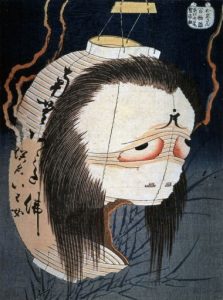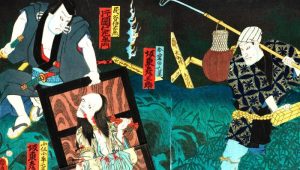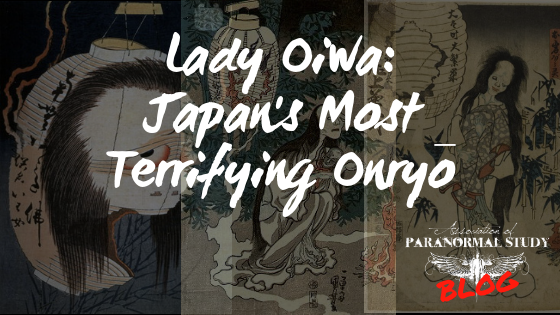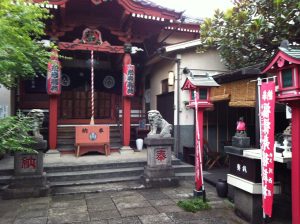Being both in theatre and the paranormal, I find myself searching for theatrical ghost stories. When I ran into a kabuki play called, “Yotsuya Kaidan” by Tsuruya Nanboku IV, I felt like I struck gold. At the time, I was looking for something to adapt to the stage as a modern tale in the horror genre. I actually wanted to do what they did with “Sleep No More” and make it similar to a haunted house, or an immersive theatrical experience. However, I found myself shying away from the project once I learned that Lady Oiwa’s curse was more ruthless than the Macbeth curse. As someone who doesn’t wish to tempt fate, I shelved my modern retelling of “Yotsuya Kaidan”, at least until I can get to Japan and ask Lady Oiwa’s permission and leave her a gift at her grave.
Do I believe in theatre superstitions? Sometimes. I find myself whistling often in a theatre and haven’t had repercussions. Yet, I have found myself becoming prey to the Macbeth curse, but that’s another tale for another time.
Long story short, “Yotsuya Kaidan” was first staged in 1825 in what is modern-day Tokyo and takes place during the Edo period in Japan. The play was a hit and the theatre actually had to schedule additional performances. It didn’t take long for the play to be produced all over Japan. What people didn’t realize that there would be dire consequences coming to those who chose to produce Lady Oiwa’s tale.
A Brief Summary
 There are a few variations of the story. They all have Oiwa married to a samurai named Tamiya Iemon. One night, Iemon and Oiwa’s father Samon, were in a heated argument. When Samon suggested to Iemon that he separates from Oiwa, Iemon kills the man and tells Oiwa that a stranger murdered her father. Iemon is also a man who is bad with money and ends up pawning many of their possessions. The couple ends up having a son.
There are a few variations of the story. They all have Oiwa married to a samurai named Tamiya Iemon. One night, Iemon and Oiwa’s father Samon, were in a heated argument. When Samon suggested to Iemon that he separates from Oiwa, Iemon kills the man and tells Oiwa that a stranger murdered her father. Iemon is also a man who is bad with money and ends up pawning many of their possessions. The couple ends up having a son.
Some variations of the story have Iemon becoming resentful of Oiwa, while others have him lose interest in her once her face becomes disfigured. In one version, a girl named Oume has fallen in love with Iemon and her doctor father gives Oiwa an ointment that disfigures her face and causes her hair to fall out, which results in Iemon becoming disgusted with her. Other variations have Iemon involved in the scheme. Iemon eventually tries to get a man named Takuetsu to rape Oiwa so that he can leave her on grounds of infidelity. But once Takuetsu looks at her face, he can’t go through with the plan. He shows Oiwa her face, and she becomes so horrified that she takes a sword and slits her own throat. Other versions have her dying by accident where she holds a sword and tries to evade Takuetsu, only to accidentally puncture herself. In all these versions, she curses Iemon’s name until she dies. Some versions have Lady Oiwa growing mad by herself and falling on one of Iemon’s swords, and he’s the one that finds her when he gets home.
Some versions have Oiwa’s body being discovered by a servant named Kohei. When Kohei sees Iemon overjoyed over Oiwa’s passing, he becomes suspicious. Iemon kills Kohei, nails both bodies to a door and throws it into the river. Iemon then says that Kohei and Oiwa were having an affair.
Iemon proceeds to marry Oume, but Lady Oiwa’s ghost is quick to act. On his wedding night, Iemon sees Oiwa’s face in bed with him. Iemon gets his sword and attacks. However, once he snaps out of it, he realizes that he killed his new bride. When he goes to Oume’s father (or grandfather in some versions), he kills him as well, believing to be haunted by Kohei.
Oiwa continues to stalk and torment Iemon. She even appeared in paper lanterns and cried out to him in vengeance. All of this eventually caused him to descend into madness in an isolated mountain retreat. A lot of people die. If this piques your interest, definitely check out the play. There’s a lot I left out!
The “Real” Story
According to legend, Lady Oiwa was indeed a real person who died in 1636. She is supposedly buried in Myogyo-ji, in Sugamo, a neighborhood of Tokyo. However, there was a shrine and memorial erected in her honor near the location of her family’s home in Yotsuya. It burned down in 1879. A new shrine was erected in another location but got destroyed by the bombs of World War II. Then, a third shrine was erected at the first site in Yotsuya that you can visit today. When it comes to inspiration, there were two real-life murders that had become extremely popular at the time of Nanboku’s life. One was a samurai who had discovered that his concubine was being unfaithful. He nailed her body to a door and threw it into the Kanda River. The other murder involved two servants who killed their masters. The servants were executed that same day.
What is an Onryō?
An onryō is the vengeful spirit (typically a woman) who was wronged in life. She is usually dressed in a ceremonial white kimono (what she was likely buried in). Their vengeance is so powerful that it creates a bridge between the world of the living and the land of the dead, the Yomi. Think of Yomi as their version of hell. In contrast, there is the Takamagahara, essentially heaven. Think of these women being powerless while they were living. It is only until they die that they gain their power. In Lady Oiwa’s case, she was a victim of outside circumstances of those who wanted something for personal gain. She was an innocent. In appearance, Lady Oiwa is disfigured on her left side, with her eye drooping from the poison. Her head is usually bald on this left side from her hair falling out in clumps. It is rumored that Lady Oiwa’s onryō still haunts her home in Yotsuya, where the shrine is located. Sadako Yamamura, or Samara in the American adaptation, from “The Ring” is a nod to Lady Oiwa, in case you needed to feel more scared.

Why the Curse?
We’re all familiar with the Macbeth curse. But the curse of Lady Oiwa is more terrifying, in my opinion. Those who have worked on adaptations of Lady Oiwa’s tale have been met with misfortune like car accidents and even death. If you want to present Lady Oiwa’s story, legend says that you have to visit her grave and ask for permission. It has become a requirement in recent years because the curse is believed wholeheartedly. If you visit Lady Oiwa’s grave and you wish hard enough, your wish might come true.
The earliest film adaptation was made in 1912 and was filmed 18 more times between 1913 and 1937. Another adaptation was made in 1949 with another in 1956 and 1959. The 2006 anime adaptation was what originally caught my attention, and it goes into more details about the curse.
As someone who had an interest in the paranormal and artistic endeavors, the curse makes sense from a moral standpoint. Poor Lady Oiwa continues to be taken advantage of. When you think about it, these theatrical and film adaptations usually make some sort of profit from her story. If they don’t get permission to present her story, then it makes sense to me that she would even the score on a karmatic scale. Given her grisly circumstances in the play and (now) legend, I’d be pretty ticked off too.
Ironically, Universal Studio Singapore is featuring Lady Oiwa in their Halloween Horror Nights this year with a full haunted house dedicated to her. I find it truly fascinating. I have to wonder what Lady Oiwa thinks about this? I hope they got her permission to do so. If not, perhaps we need to keep an eye on the headlines in Singapore for the next few months.
Check out the interactive video below.
Here’s another video of the immersive experience:
Sources:
Yotsuya Kaidan and Japanese Ghosts
http://www.weirdwildrealm.com/f-yotsuyakaidan.html
The Tragic Tale of Lady Oiwa and Adapting the <i>Onryō</i> for a Contemporary audience



Excellent article, vey insightful. Great job!